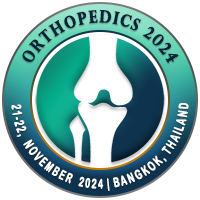
Amr Mansour
Hillel Yaffe Medical Center, IsraelTitle: Post-lumbar laminectomy arachnoiditis
Abstract
Spinal nerve root arachnoiditis is caused by an inflammation of the arachnoid membrane which can result from many possible causes such as spinal surgery, myelography, infections, or trauma to the spine
As the inflammation progresses, scar tissue build-up occurs in the arachnoid mater, which causes adhesions to the nerve roots.
Recent studies show that up to 90% of arachnoiditis has been linked to lumbar spine surgery.
Symptoms are usually non-specific, such as a burning sensation in the lower back which radiates down the legs to a non-particular dermatome, burning in the sacral area, knees and feet, as well as neurogenic bladder symptoms.
Case presentation
A 72-year-old male with HTN, IHD, and an overactive bladder presented with significant lumbar spinal stenosis and severe neurogenic claudication. He had no .lower back pain or signs of radiological lumbar instability.
The patient was operated on due to deterioration in walking capacity and underwent a single-level decompression surgery at L4-L5. During surgery, a dural tear was diagnosed, without any visible CSF leak. After a wide decompression, the tear was repaired with no dural tension.
Three weeks following the surgery the patient was once again admitted to our department due to urosepsis and complaints of bladder and bowel dysfunction. There were no back or lower limb complaints noted.
His physical exam showed no signs of surgical wound infection and an intact lower limb motor exam, however diminished perianal sensation was evident.
During his admission, he underwent a lumbar MRI with contrast that diagnosed acute arachnoiditis.
In consultation with the neurology department, the patient was treated with pentoxifylline and prednisone as well as antibiotics for his UTI.
He was released with a permanent catheter and further evaluation is being conducted by both the orthopedic and the urology departments.
Conclusion
Arachnoiditis should always be considered in patients that present bladder dysfunction or atypical symptoms following lumbar decompression surgery, and a thorough evaluation is necessary to rule out this condition. Additionally, early recognition and repair of dural tears are essential to avoid the development of arachnoiditis and its advancement to neurological deterioration.
Biography
Spinal nerve root arachnoiditis is caused by an inflammation of the arachnoid membrane which can result from many possible causes such as spinal surgery, myelography, infections, or trauma to the spine As the inflammation progresses, scar tissue build-up occurs in the arachnoid mater, which causes adhesions to the nerve roots. Recent studies show that up to 90% of arachnoiditis has been linked to lumbar spine surgery. Symptoms are usually non-specific, such as a burning sensation in the lower back which radiates down the legs to a non-particular dermatome, burning in the sacral area, knees and feet, as well as neurogenic bladder symptoms. Case presentation A 72-year-old male with HTN, IHD, and an overactive bladder presented with significant lumbar spinal stenosis and severe neurogenic claudication. He had no .lower back pain or signs of radiological lumbar instability. The patient was operated on due to deterioration in walking capacity and underwent a single-level decompression surgery at L4-L5. During surgery, a dural tear was diagnosed, without any visible CSF leak. After a wide decompression, the tear was repaired with no dural tension. Three weeks following the surgery the patient was once again admitted to our department due to urosepsis and complaints of bladder and bowel dysfunction. There were no back or lower limb complaints noted. His physical exam showed no signs of surgical wound infection and an intact lower limb motor exam, however diminished perianal sensation was evident. During his admission, he underwent a lumbar MRI with contrast that diagnosed acute arachnoiditis. In consultation with the neurology department, the patient was treated with pentoxifylline and prednisone as well as antibiotics for his UTI. He was released with a permanent catheter and further evaluation is being conducted by both the orthopedic and the urology departments. Conclusion Arachnoiditis should always be considered in patients that present bladder dysfunction or atypical symptoms following lumbar decompression surgery, and a thorough evaluation is necessary to rule out this condition. Additionally, early recognition and repair of dural tears are essential to avoid the development of arachnoiditis and its advancement to neurological deterioration.

